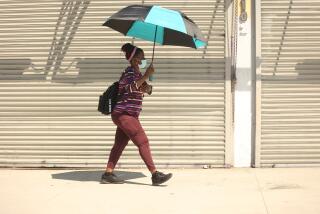Recognize Danger Signals of Losing Your Cool : Hot, humid weather can result in heat cramps or life-threatening heat stroke. Treatment begins by knowing the symptoms.
- Share via
The tropics and the desert are great vacation destinations, but they can increase the risk of the body’s “thermostat” going awry. Even a visit to the American South or humid Midwest, during the heat of the summer, can cause health problems for travelers who overexert themselves or don’t heed the body’s warning signs that exhaustion is imminent.
Heat-related problems run the gamut, from heat cramps that can often be relieved by resting and drinking water to life-threatening heat stroke, which demands immediate medical attention.
“Heat illness is a result of the body’s inability to dissipate heat,” said Dr. Christopher Allen, an emergency physician at Desert Hospital in Palm Springs. If your vacation destination is both hot and humid, the result can be a double whammy since humidity hinders heat loss through the skin, according to Dr. Susi Vassallo, instructor in clinical emergency medicine at New York University Medical School--Bellevue Hospital. And if your destination is hot, humid and loaded with insects, the problems can be further compounded, Vassallo said. Suppose you are hiking and bird-watching in Costa Rica. “It’s hot but you’re covered up (to avoid insect bites),” she said. This can create the perfect setup for heat illness.
The chances of heat problems are also higher in the elderly, especially among those who are taking certain medications or exercising strenuously before the body has adjusted itself to the new climate.
The key to minimizing complications, experts agree, is to pay attention to all symptoms, which may include feelings of weakness, nausea, vomiting, fatigue and/or thirst.
The least serious of the heat disorders are heat cramps that most often strike the leg muscles but can also affect others. “Heat cramps are due to dehydration,” said Vassallo. They often occur in young, active people exercising in a climate that is hotter or more humid than their normal environment.
“Get out of the heat and spray yourself with water,” Allen said. Drink fluids, such as water or a sports drink, move to a shady place and remove as much clothing as possible. “If you don’t turn around in a few minutes, seek medical attention,” Allen said. If you ignore heat cramps, the problem may progress to heat exhaustion.
Heat stroke, the most serious kind of heat problem, is marked by a change in mental status, Vassallo said, although chills, weakness or nausea might be the first symptoms a victim notices.
When this occurs, “the protein in the brain is being ‘cooked,’ ” Allen said. The body temperature is highly elevated, often 104 degrees or more, but Allen emphasized that body temperature does not always determine how serious the condition is.
Often, victims of heat stroke are so disoriented they need to be taken to the hospital by someone else, Allen said. If heat stroke is suspected, the victim should be cooled down immediately. “Move them to a shady place; take off as many clothes as possible. And pour water and ice over them so that the whole body is cooled,” Vassallo said.
Heat stroke victims require immediate medical attention. Complications of heat stroke can include seizures and liver and kidney failure. About 25% of heat stroke victims die, according to Allen.
To minimize the chance of heat disorders, vacation travelers should try to acclimatize themselves to a new environment slowly once they arrive, experts said. Although most people don’t have the time or patience to do that, especially if vacation time is limited, taking physical tasks slowly, at least, could be helpful. “Acclimatization time for vacationers varies from about three to seven days,” Allen said, emphasizing, though, that the time required varies greatly, depending on a person’s physical condition, the gap between home and destination environment, and how active a vacationer is while at the new location. The fitter a person is, the quicker acclimatization will occur.
Another route is to try to adjust to destination temperatures before leaving home, Allen said. While this may be difficult, a runner traveling to hot, muggy Key West to run a race, for example, should try to exercise at home at the same temperature as is likely to occur during the race.
Other measures to reduce risk:
* Drink lots of water to minimize dehydration.
* Minimize intake of alcoholic beverages, Vassallo advised, especially after exercising. “If you are hot, say, after tennis at Hilton Head (S.C.),” Vassallo said, “four beers will only dehydrate you.”
* Be especially careful if you are taking medications that can set you up for heat-related problems. Anyone taking antihistamines (found in cold medicines, hay fever remedies and other drugs) or cardiac medicines that slow the heart should be particularly alert for symptoms of heat illness, Allen said. “Antihistamines interfere with sweat gland functioning,” Vassallo said. A slowed heart rate brought about by cardiac medicines also decreases the body’s ability to cope with heat, Allen said.
* Wear light, loose clothing that allows air flow while protecting the body from direct sunlight.
* “Be sure you are physically fit for whatever you are doing,” Allen added.
More to Read
Sign up for The Wild
We’ll help you find the best places to hike, bike and run, as well as the perfect silent spots for meditation and yoga.
You may occasionally receive promotional content from the Los Angeles Times.






